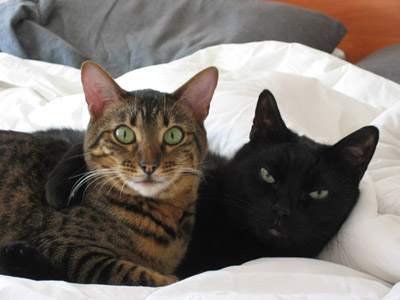Gratuitous Cat Picture #2
I did not do this to her...

Indeed, I did not stage, pose, alter or encourage this shot in any way. She did it all herself.
<<< Previous GCP ---- Next GCP >>>
We're an ordinary couple who, one day, bought a Bengal kitten. We soon learned that Bengal cats aren't like other cats. But we've learned some tricks along the way, and we've survived. You can too.
I did not do this to her...

<<< Previous GCP ---- Next GCP >>>
For your general amusement, from The Joy of Tech.
If you have a Bengal for a pet, sooner or later (usually sooner) someone is going to worry about whether it's safe to be around. Family members will fear for your life. Friends will worry about whether it's safe to let their children visit your home with this wild animal running loose. It's probably the number one concern of people who aren't really familiar with Bengals.
Number one in a series... Just because she's cute:

Next GCP >>>
Sigh. No. Though we do get that reaction sometimes, especially from the in-laws, who seem to think we've taken in some ravenous man-eater that's going to maul us to death at any moment. (Okay, our tales of her antics may not have helped there...)
This is about life with cats ... when one of them is a Bengal. Here are the cats in question. Laszlo, neutered male, black, about eight years old, very mellow and dignified. We think of him as a sort of feline Oscar Wilde. And Leela, neutered female, about ten months old, and a Bengal which pretty much says it all.

The nature of blog design means that posts gradually trail off the main page and into the archives where, honestly, no one's ever likely to see them again. For steady readers, that's not much of a problem. But if you randomly stroll into a newly discovered blog, you're likely to miss posts you'd really enjoy, or just basic information about what's going on here.